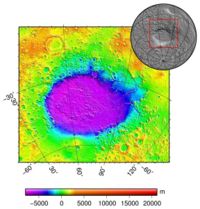Crater
In it's broadest sense, a crater is simply a circular depression in the surface of a planet. Generally, in solar system geology, craters are formed either by meteorites or volcanic activity.
Meteorite Impact

Hyper-velocity objects impacting the Mars surface cause highly energetic impacts, ejecting rock, dust and gases into the atmosphere and surrounding landscape. Most of Mars' cratering by meteorites was caused during the Late Heavy Bombardment period of the Solar System, over 3.9 billion years ago.[1] A large meteorite impacted the Mars surface around this time, creating the obvious Hellas Basin in the southern hemisphere.
The Martian dichotomy, between the old south and the new north has also been attributed to an immense impact crater early in the life of the planet. An alternative cause might be convective currents in the Early Martian Crust, causing an effect similar to the supercontinents that have existed on Earth through plate tectonics. The cooling of Mars would have interrupted these currents leaving a single supercontinent and a single ocean on Mars.
Volcanic Activity
Although tectonic activity on Mars is widely believed to be intermittent at best, evidence of it's volcanic past is evident in the many volcano craters littering the surface. The largest volcano caldera is the famous Olympus Mons, the largest known volcano in the Solar System.






